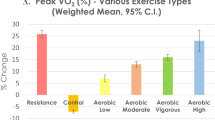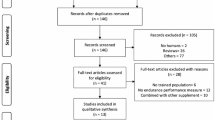Abstract
Purpose
To investigate the effect of aerobic exercise (AE) versus resistance exercise (RE) on outcomes of cardiac autonomic recovery in type 2 diabetes mellitus (T2DM) patients with cardiac autonomic neuropathy (CAN).
Methods
Fifty T2DM patients with CAN (age: 52.2 ± 6.8 years) were recruited for the present study. They were randomly allocated into two groups: AE (n = 25) and RE (n = 25). The AE group performed graded maximal exercise test using Balke protocol while the RE group performed 5 sets of leg press exercise at 10 repetition maximum (RM) intensity. Heart rate variability (HRV) was assessed for 10 min after both exercise bouts while heart rate recovery (HRR) was recorded for the first 3 min after completion of the exercise bouts. Key outcome measures for the study were standard time and frequency domain parameters of HRV and HRR1min, HRR2min, and HRR3min. Standard statistical analysis which included independent t-test and repeated measures analysis of variance was performed in order to test the study hypothesis.
Results
Significant impairment was observed in both HRV and HRR after both AE and RE (p < 0.05). However, alterations in both HRV and HRR responses were found to be more after AE as compared to RE (p < 0.05) in T2DM patients with CAN.
Conclusion
Findings of the present study suggest significant blunting of autonomic responses after both AE and RE in T2DM patients with CAN. However, deterioration in them was found to be more after AE as compared to the RE indicating that AE may pose greater stress on the cardiovascular system of T2DM patients with CAN.
Similar content being viewed by others
Abbreviations
- 30:15 ratio:
-
Ratio of the longest R-R interval during 30 s and the shortest R-R interval during 15th second of the head-up tilt test
- AE:
-
Aerobic exercise
- ANCOVA:
-
Analysis of covariance
- ANS:
-
Autonomic nervous system
- BP:
-
Blood pressure
- BRS:
-
Baroreflex sensitivity
- CAN:
-
Cardiac autonomic neuropathy
- CARTs:
-
Cardiovascular autonomic reflex tests
- CVD:
-
Cardiovascular disease
- DBP:
-
Diastolic blood pressure
- DBT:
-
Deep breathing test
- E:I ratio:
-
Ratio of the average of longest R-R interval during expiration and the shortest R-R interval during inspiration of the deep breathing test
- ECG:
-
Electrocardiogram
- HF:
-
High frequency
- HGT:
-
Hand grip test
- HR:
-
Heart rate
- HRR:
-
Heart rate recovery
- HRV:
-
Heart rate variability
- HUT:
-
Head-up tilt
- LF/HF ratio:
-
Ratio of low- and high-frequency power
- LF:
-
Low frequency
- Mean NN:
-
Average of N–N intervals
- MHR:
-
Maximal heart rate
- pNN50:
-
Proportion of differences in consecutive N–N intervals that are longer than 50 ms
- PNS:
-
Parasympathetic nervous system
- RE:
-
Resistance exercise
- RM:
-
Repetition maximum
- RMSSD:
-
Root mean square of successive differences between adjacent R-R intervals
- SBP:
-
Systolic blood pressure
- SDNN:
-
Standard deviation of N–N intervals
- SNS:
-
Sympathetic nervous system
- T2DM:
-
Type 2 diabetes mellitus
- TP:
-
Total power
- VM:
-
Valsalva maneuver
- VR:
-
Valsalva ratio
- ΔHR:
-
Change in R-R intervals during six consecutive cycles of deep inspiration and expiration
References
American Diabetes Association. 2. Classification and diagnosis of diabetes: standards of medical care in diabetes-2020. Diabetes Care. 2020;43:S14-31. https://doi.org/10.2337/dc20-S002.
Serhiyenko VA, Serhiyenko AA. Cardiac autonomic neuropathy: risk factors, diagnosis and treatment. World J Diabetes. 2018;9:1–24. https://doi.org/10.4239/wjd.v9.i1.1.
Michael S, Graham KS, Davis GM. Cardiac autonomic responses during exercise and post-exercise recovery using heart rate variability and systolic time intervals—a review. Front Physiol. 2017;8:301. https://doi.org/10.3389/fphys.2017.00301.
Banthia S, Bergner DW, Chicos AB, Ng J, Pelchovitz DJ, Subacius H, et al. Detection of cardiovascular autonomic neuropathy using exercise testing in patients with type 2 diabetes mellitus. J Diabetes Complications. 2013;27:64–9. https://doi.org/10.1016/j.jdiacomp.2012.09.002.
Verma S, Bhati P, Ahmad I, Masroor S, Ali K, Singla D, et al. Co-existence of hypertension worsens post-exercise cardiac autonomic recovery in type 2 diabetes. Indian Heart J. 2018;70:S82–9. https://doi.org/10.1016/j.ihj.2018.06.007.
Sacre JW, Jellis CL, Coombes JS, Marwick TH. Diagnostic accuracy of heart-rate recovery after exercise in the assessment of diabetic cardiac autonomic neuropathy. Diabet Med. 2012;29:e312–20. https://doi.org/10.1111/j.1464-5491.2012.03719.x.
Colberg SR, Sigal RJ, Fernhall B, Regensteiner JG, Blissmer BJ, Rubin RR, et al. Exercise and type 2 diabetes: the American College of Sports Medicine and the American Diabetes Association: joint position statement executive summary. Diabetes Care. 2010;33:2692–6. https://doi.org/10.2337/dc10-9990.
Bissinger A. Cardiac autonomic neuropathy: why should cardiologists care about that? J Diabetes Res. 2017;2017:1–9. https://doi.org/10.1155/2017/5374176.
de Paula T, Neves MF, da Silva IA, Monteiro W, Farinatti P, Cunha FA. Acute effect of aerobic and strength exercise on heart rate variability and baroreflex sensitivity in men with autonomic dysfunction. J Strength Cond Res. 2019;33:2743–52. https://doi.org/10.1519/JSC.0000000000002372.
American Diabetes Association. 2. Classification and diagnosis of diabetes. Diabetes Care. 2016;39:S13–22. https://doi.org/10.2337/dc16-S005.
Ewing DJ, Martyn CN, Young RJ, Clarke BF. The value of cardiovascular autonomic function tests: 10 years experience in diabetes. Diabetes Care. 1985;8:491–8. https://doi.org/10.2337/diacare.8.5.491.
Criteria Committee of the New York Heart Association. Nomenclature and criteria for diagnosis of diseases of the heart and great vessels. 9th ed. Boston: Little, Brown & Company; 1994. p. 253–6.
Beltz NM, Gibson AL, Janot JM, Kravitz L, Mermier CM, Dalleck LC. Graded exercise testing protocols for the determination of VO2max: historical perspectives, progress, and future considerations. J Sports Med. 2016. https://doi.org/10.1155/2016/3968393.
Bhati P, Moiz JA, Naqvi IH, Hussain ME. Diagnostic performance of resting and post-exercise heart rate variability for detecting cardiac autonomic neuropathy in type 2 diabetes mellitus. Auton Neurosci. 2019;219:53–65. https://doi.org/10.1016/j.autneu.2019.04.003.
Neves VR, Kiviniemi AM, Hautala AJ, Karjalainen J, Piira OP, Catai AM, et al. Heart rate dynamics after exercise in cardiac patients with and without type 2 diabetes. Front Physiol. 2011;2:57. https://doi.org/10.3389/fphys.2011.00057.
Cheng YJ, Lauer MS, Earnest CP, Church TS, Kampert JB, Gibbons LW, et al. Heart rate recovery following maximal exercise testing as a predictor of cardiovascular disease and all-cause mortality in men with diabetes. Diabetes Care. 2003;26:2052–7. https://doi.org/10.2337/diacare.26.7.2052.
Choi A, Shin H. Quantitative analysis of the effect of an ectopic beat on the heart rate variability in the resting condition. Front Physiol. 2018;9:922. https://doi.org/10.3389/fphys.2018.00922.
Gąsior JS, Sacha J, Jeleń PJ, Zieliński J, Przybylski J. Heart rate and respiratory rate influence on heart rate variability repeatability: effects of the correction for the prevailing heart rate. Front Physiol. 2016;7:356. https://doi.org/10.3389/fphys.2016.00356.
Task Force of the European Society of Cardiology and the North American Society of Pacing and Electrophysiology. Heart rate variability: standards of measurement, physiological interpretation and clinical use. Circulation. 1996;93:1043–65. https://doi.org/10.1161/01.CIR.93.5.1043.
Storniolo JL, Esposti R, Cavallari P. Heart rate kinetics and sympatho-vagal balance accompanying a maximal sprint test. Front Psychol. 2020;10:2950. https://doi.org/10.3389/fpsyg.2019.02950.
Chacko KM, Bauer TA, Dale RA, Dixon JA, Schrier RW, Estacio RO. Heart rate recovery predicts mortality and cardiovascular events in patients with type 2 diabetes. Med Sci Sports Exerc. 2008;40:288–95. https://doi.org/10.1249/mss.0b013e31815c4844.
Enciu E, Stanciu S, Matei D, Roul G. Autonomic nervous system dysfunction and abnormal heart rate recovery. Arch Cardiovasc Dis Suppl. 2018;10:116. https://doi.org/10.1016/j.acvdsp.2017.11.198.
Vianna JM, Werneck FZ, Coelho EF, Damasceno VO, Reis VM. Oxygen uptake and heart rate kinetics after different types of resistance exercise. J Hum Kinet. 2014;42:235–44. https://doi.org/10.2478/hukin-2014-0077.
Schamne JC, Ferreira Junior A, Araújo AC, Lima-Silva AE, Bertuzzi RC, Okuno NM. Cardiac autonomic responses during and after a single session of aerobic exercise with and without blood flow restriction. Motriz Rev Educ Fís. 2019;25. https://doi.org/10.1590/s1980-6574201900030015.
Niemela TH, Kiviniemi AM, Hautala AJ, Salmi JA, Linnamo V, Tulppo MP. Recovery patternof baroreflex sensitivity after exercise. Med Sci Sports Exerc. 2008;40:864–70. https://doi.org/10.1249/MSS.0b013e3181666f08.
Trevizani GA, Peçanha T, Nasario-Junior O, Vianna JM, Silva LP, Nadal J. Cardiac autonomic responses after resistance exercise in treated hypertensive subjects. Front Physiol. 2015;6:258. https://doi.org/10.3389/fphys.2015.00258.
Heffernan KS, Kelly EE, Collier SR, Fernhall B. Cardiac autonomic modulation during recovery from acute endurance versus resistance exercise. Eur J Cardiovasc Prev Rehabil. 2006;13:80–6. https://doi.org/10.1097/01.hjr.0000197470.74070.46.
Heffernan KS, Collier SR, Kelly EE, Jae SY, Fernhall B. Arterial stiffness and baroreflex sensitivity following bouts of aerobic and resistance exercise. Int J Sports Med. 2007;28:197–203. https://doi.org/10.1055/s-2006-924290.
Bhati P, Moiz JA, Menon GR, Hussain ME. Does resistance training modulate cardiac autonomic control? A systematic review and meta-analysis. Clin Auton Res. 2019;29:75–103. https://doi.org/10.1007/s10286-018-0558-3.
Patel H, Alkhawam H, Madanieh R, Shah N, Kosmas CE, Vittorio TJ. Aerobic vs anaerobic exercise training effects on the cardiovascular system. World J Cardiol. 2017;9:134–8. https://doi.org/10.4330/wjc.v9.i2.134.
Acknowledgements
A sincere thanks to Jamia Millia Islamia (A Central University) for providing logistic help during this study. We would also like to extend our gratitude to the University Grants Commission, India, for providing fellowship to author P. B. during this study.
Author information
Authors and Affiliations
Corresponding author
Ethics declarations
Ethics approval and consent to participate
The present trial was ethically approved by the Institutional Ethics Committee, Jamia Millia Islamia (A Central University), New Delhi, India. A written informed consent was obtained from each participant for their participation in the study.
Consent for publication
Not applicable.
Competing interest
The authors declare no competing interests.
Additional information
Publisher's note
Springer Nature remains neutral with regard to jurisdictional claims in published maps and institutional affiliations.
Rights and permissions
About this article
Cite this article
Bhati, P., Hussain, M.E. Cardiac autonomic recovery in response to aerobic versus resistance exercise in type 2 diabetes mellitus patients. Int J Diabetes Dev Ctries 42, 552–559 (2022). https://doi.org/10.1007/s13410-021-01013-8
Received:
Accepted:
Published:
Issue Date:
DOI: https://doi.org/10.1007/s13410-021-01013-8




